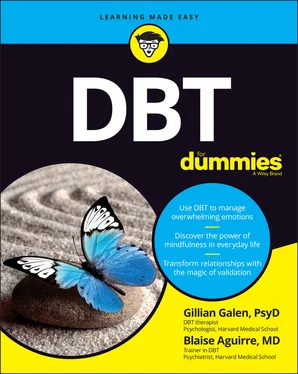Joy: A feeling of pleasure, happiness, or contentment
Love: An intense feeling of deep affection
Sadness: A feeling of sorrow or unhappiness
Anger: A strong feeling of annoyance, displeasure, or hostility
Fear: A strong feeling that something or someone is dangerous or likely to cause harm or threat
Guilt: A feeling of having done wrong, failed an obligation, or crossed a personal value
Shame: A painful feeling of humiliation or distress caused by the awareness of foolish behavior or behavior that crosses societal norms and that leaves you feeling ostracized or different
Envy: A feeling of discontentment due to the desire to have a possession, attribute, or quality that someone else has
Jealousy: A feeling of uneasiness from suspicion or fear of rivalry, or fear of something deeply important to you being taken
Disgust: A feeling of revulsion or strong disapproval aroused by something unpleasant or offensive
 Many of these emotions may be very familiar to you. We encourage you to look closely at two sets of emotions that are often less familiar and are frequently used incorrectly in common language. Look closely at the definitions of guilt and shame, and jealousy and envy. Better understanding the definition of these emotions will help you know how to label your experience.
Many of these emotions may be very familiar to you. We encourage you to look closely at two sets of emotions that are often less familiar and are frequently used incorrectly in common language. Look closely at the definitions of guilt and shame, and jealousy and envy. Better understanding the definition of these emotions will help you know how to label your experience.
Understanding your emotions would be a little easier if not for secondary emotions. Secondary emotions are where you may get tripped up. These emotions are most commonly the result of thinking about your primary emotion. Your beliefs, judgments, and attitudes about emotions move you into secondary emotions — for example, getting sad and then thinking that sadness is weakness and so getting angry. Sadness is the primary emotion, the one that makes sense in the context of what you just experienced, and anger is the secondary emotion resulting from your beliefs and judgments about sadness.
 A primary emotion lasts an average of 90 seconds if we don’t apply a chain of thinking that turns it into a secondary emotion. The problem with secondary emotions is they can last a long time — hours, days, weeks, months. You can get stuck in secondary emotions, and those emotions tend to perpetuate themselves with ease. Feeling miserable is a great example of getting stuck in a mix of secondary emotions. One tricky thing about secondary emotions is that a primary emotion can, in fact, also be a secondary emotion. If your beliefs, judgments, and attitudes about sadness lead you to feel more sadness, then sadness is also secondary. Self-invalidation and invalidation from others is an easy way to land in a secondary emotional experience. So, if you experience an emotion lasting more than 90 seconds (before something else prompts it), then you’re likely inadvertently making sadness stick around longer than it needs to. It’s actually a great clue! This is why it’s so critical to learn to pay attention and be able to identify, label, understand, and validate your emotions.
A primary emotion lasts an average of 90 seconds if we don’t apply a chain of thinking that turns it into a secondary emotion. The problem with secondary emotions is they can last a long time — hours, days, weeks, months. You can get stuck in secondary emotions, and those emotions tend to perpetuate themselves with ease. Feeling miserable is a great example of getting stuck in a mix of secondary emotions. One tricky thing about secondary emotions is that a primary emotion can, in fact, also be a secondary emotion. If your beliefs, judgments, and attitudes about sadness lead you to feel more sadness, then sadness is also secondary. Self-invalidation and invalidation from others is an easy way to land in a secondary emotional experience. So, if you experience an emotion lasting more than 90 seconds (before something else prompts it), then you’re likely inadvertently making sadness stick around longer than it needs to. It’s actually a great clue! This is why it’s so critical to learn to pay attention and be able to identify, label, understand, and validate your emotions.
Paying attention to what you feel
Paying attention to what you’re feeling requires an openness and willingness to shine a light on your emotional experience. We know that when you look directly at an emotion, the intensity of it begins to decrease. If you’re doubtful, we encourage you to try this sooner rather than later. Identifying an emotion and validating it — recognizing how it makes sense and is valid — is a powerful and healing experience.
So, where do you start? In DBT we have a skill called mindfulness of current emotion, and we break it down into steps using the acronym SUN WAVE NO NOT. Using this skill will help you identify the primary emotion and label it. Follow the steps in this section to do so.
 When you’re just starting to use this skill, it can be helpful to write down your answers on a piece of paper. Take your time; it can be a slower process in the beginning, but once you practice, you’ll be able to simply pause and identify your emotions much of the time without even using all of the following steps.
When you’re just starting to use this skill, it can be helpful to write down your answers on a piece of paper. Take your time; it can be a slower process in the beginning, but once you practice, you’ll be able to simply pause and identify your emotions much of the time without even using all of the following steps.
 The acronym SUN stands for Sensations, Urges, and Name the emotion:
The acronym SUN stands for Sensations, Urges, and Name the emotion:
Sensations: All emotions have associated sensations. Your body holds important clues about how and what you’re feeling. Briefly scan your body, starting at your head and moving down to your toes. Do you feel a tightness or clenching of your jaw? Warmth in your cheeks? Throbbing in your head? Tears in your eyes? Tightness in your chest? Butterflies or a sinking feeling in your stomach? Tightness or clenching of your hands?
Urges: All emotions have associated action urges. This makes sense, as one of the functions of emotions is to motivate action. For example, when you feel fear, you may have the urge to run, fight, or freeze. When you’re sad, you may feel the urge to curl up, cry, or isolate. When you feel shame, you may want to hide. When you’re angry, you may have the urge to yell or hit or throw something; other people may cry when they are angry. We don’t all have the same action urges, but they tend to be similar.
Name the emotion: Once you have identified your body sensation and your urges, you typically have enough information to name the emotion. We know that once you can name the emotion, it begins to decrease in intensity. That often occurs because it gives you some space between your own experience and what you’re feeling. This also helps you find the primary emotions, which may have been hidden beneath a secondary emotion. (We discuss primary and secondary emotions earlier in this chapter.)
Once you have named the emotion, your task is to ride it like a WAVE. When a primary emotion runs its course, you’ll experience it like a wave, first lower in intensity, building up to the peak or the crest of the wave, and then slowing, decreasing in intensity until you return to baseline, or the waves settle on the shore. The way to ride the wave is to use your mindfulness “Observe and Describe Skills,” which we cover in more depth in Chapter 9. What you’ll do is notice and describe your sensations and your urges, which you’ve already identified in the SUN part of this practice (see the previous section). Notice and describe without judgment the facts of your experience. For example, you may notice your thoughts moving quickly, a sensation of butterflies in your stomach, your face feeling red, and tears running down your cheeks.
You’ll notice that this is a somewhat boring process as there are no judgments or editorials about your experience that pull in the past or the future. This is what helps your emotions simply run their course. Repeat this process until the intensity of your emotions becomes more manageable.
The final phase consists of NO NOT:
NO: No suppressing your emotions. No enhancing your emotions. This means that you don’t tell yourself that you can’t feel something, and you don’t do things that increase the intensity of an unwanted emotion such as judging and invalidating it. You can think about this phase as consisting of things to avoid when you are riding the WAVE from the previous section.
Читать дальше

 Many of these emotions may be very familiar to you. We encourage you to look closely at two sets of emotions that are often less familiar and are frequently used incorrectly in common language. Look closely at the definitions of guilt and shame, and jealousy and envy. Better understanding the definition of these emotions will help you know how to label your experience.
Many of these emotions may be very familiar to you. We encourage you to look closely at two sets of emotions that are often less familiar and are frequently used incorrectly in common language. Look closely at the definitions of guilt and shame, and jealousy and envy. Better understanding the definition of these emotions will help you know how to label your experience. A primary emotion lasts an average of 90 seconds if we don’t apply a chain of thinking that turns it into a secondary emotion. The problem with secondary emotions is they can last a long time — hours, days, weeks, months. You can get stuck in secondary emotions, and those emotions tend to perpetuate themselves with ease. Feeling miserable is a great example of getting stuck in a mix of secondary emotions. One tricky thing about secondary emotions is that a primary emotion can, in fact, also be a secondary emotion. If your beliefs, judgments, and attitudes about sadness lead you to feel more sadness, then sadness is also secondary. Self-invalidation and invalidation from others is an easy way to land in a secondary emotional experience. So, if you experience an emotion lasting more than 90 seconds (before something else prompts it), then you’re likely inadvertently making sadness stick around longer than it needs to. It’s actually a great clue! This is why it’s so critical to learn to pay attention and be able to identify, label, understand, and validate your emotions.
A primary emotion lasts an average of 90 seconds if we don’t apply a chain of thinking that turns it into a secondary emotion. The problem with secondary emotions is they can last a long time — hours, days, weeks, months. You can get stuck in secondary emotions, and those emotions tend to perpetuate themselves with ease. Feeling miserable is a great example of getting stuck in a mix of secondary emotions. One tricky thing about secondary emotions is that a primary emotion can, in fact, also be a secondary emotion. If your beliefs, judgments, and attitudes about sadness lead you to feel more sadness, then sadness is also secondary. Self-invalidation and invalidation from others is an easy way to land in a secondary emotional experience. So, if you experience an emotion lasting more than 90 seconds (before something else prompts it), then you’re likely inadvertently making sadness stick around longer than it needs to. It’s actually a great clue! This is why it’s so critical to learn to pay attention and be able to identify, label, understand, and validate your emotions.










